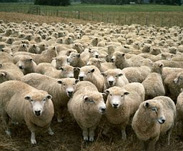About Scrapie
Scrapie is a fatal, degenerative disease affecting the central nervous system of sheep and goats. It is among a number of diseases classified as transmissible spongiform encephalopathies (TSE). Infected flocks that contain a high percentage of susceptible animals can experience significant production losses. Over a period of several years the number of infected animals increases, and the age at onset of clinical signs decreases making these flocks economically unviable. Animals sold from infected flocks spread scrapie to other flocks. The presence of scrapie in the United States also prevents the export of breeding stock, semen, and embryos to many other countries. TSEs are the subject of increased attention and concern because of the discovery of bovine spongiform encephalopathy (BSE) in cattle, the link between BSE and variant Creutzfeldt-Jakob disease (vCJD) in people, and feline spongiform encephalopathy (FSE) in cats in Europe.
Scrapie is caused by a transmissible prion or abnormal protein which is very stable in the environment. Traditional blood tests are not reliable to diagnose Scrapie, so a tissue sample is needed to diagnose it. Currently, no treatment exists for Scrapie. There is no known evidence of Scrapie transmission to humans.
While animals of any age may be exposed to Scrapie, lambs and kids are at the greatest risk of contracting the disease and are often infected by their dams shortly after birth.
Typically, infected animals don’t show signs of Scrapie, such as behavioral changes, tremors, and incoordination that progresses to recumbency and death, until they are two years of age or older.
The most effective method of Scrapie prevention is to maintain a closed flock. Raising replacement ewes, purchasing genetically resistant (RR) rams or buying from a certified-free Scrapie flock are other options to reduce the risk the Scrapie. At this time the resistant genetic markers in goats have not been identified, therefore it is important to maintain your sheep and goat herds separately.
Eradication Program
Scrapie was first reported in the United States in 1947. In 1952, The National Scrape Eradication Program (NSEP) was established. The NSEP is a mandatory program that applies to all sheep and goat producers in the United States.
The NSEP was revised in 2001 to accelerate the eradication of scrapie from the United States. The revised program requires the official identification of most sexually intact sheep and goats in commerce; additionally, it identifies scrapie-infected animals through surveillance of mature cull sheep and goats at slaughter as well as suspects reported by veterinarians and producers.
Since the incubation period for Scrapie is typically two to five years, producers should record individual identification numbers and the seller’s premises identification number on purchase and sales records. These records must be maintained for a minimum of five years. The success of the Scrapie Eradication Program is tied to producers keeping good records of animal sales and purchases.
The National Scrapie Eradication Program provides free ear tags to sheep and goat producers. To order your free ear tags, call 1-866-USDA-TAG (1-866-873-2824).
Information Links
- Animal Identification and Recordkeeping Guide for Sheep and Goats. National Scrapie Eradication Program
- USDA, APHIS, VS–Scrapie Information Page
- National Institute for Animal Agriculture — National Scrapie Education Initiative
Voluntary Scrapie Flock Certification Program (SFCP)
The Scrapie Flock Certification Program (SFCP) was added in 1992 and is a voluntary certification program within the NSEP. The SFCP identifies scrapie-free flocks by monitoring them over a 5-7 year period.
The SFCP was revised on 2013. The program provides sheep and goat producers the opportunity to increase the marketability of their animals through demonstrating a negligible scrapie risk in their flock or herd. The revised program additionally will enhance scrapie surveillance strategy, contributing to the final push to eradicate this disease from the United States.
Information Link
Scrapie Regulations
Everyone raising sheep and goats in California requires official identification issued by the USDA.
You may obtain official tags from the USDA/APHIS VS office at (916) 854-3900. If you apply official ID, you must retain records on those animals for 5 years, including the date you identified the animals and the identification numbers applied, such that animals may be traced back to their flock/herd of origin.
Official Identification (official eartags, official tattoos, official electronic identification or official premises identification numbers) are required when sheep and goats change ownership, except:
- Lambs and kids less than 18 months of age in slaughter channels that have not lambed, kidded, aborted, or are pregnant
- Low–risk goats (those not exposed to scrapie or to any sheep, unless low risk commercial sheep)
- Castrated animals less than 18 months of age that are not for exhibition.
Interstate Entry Requirements
- Sheep (Domestic) Interstate Entry Requirements
- Goat (Domestic) Interstate Entry Requirements
Interstate and Intrastate Movement of Sheep and Goats Scrapie Regulations may be found under Title 3, Division 2, Chapter 2, Article 3, Sections 760-760.9. California Code of Regulations.
Scrapie Material
Resources
Contact Us
CDFA Animal Health and Food Safety Services,
Animal Health Branch
Sacramento, California 95814
Phone: 916-900-5002
Fax: 916-900-5333
Email: ahbfeedback@cdfa.ca.gov


